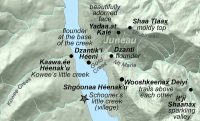
Tsaa T’ei Héen (Admiralty Cove)
‘Lost village’ of Áak’w Kwáan Every Tlingit Kwáan in Southeast Alaska has at least one ‘lost village,’ known in oral history…
2018 | Richard Carstensen | 33 pagesDiscoverySoutheast.org

For the past 30 years, I’ve grown steadily more fascinated by Tlingit and Haida geography; the history and migrations of kwáans, clans, and houses, and the ways in which natural and cultural history intersect. From February to May, 2013, I participated in a course for high school students by Goldbelt Heritage Foundation, entitled Why do we live here?

The name of the best-known winter village of Áak’w Aaní refers to the seasonal dynamic of going and coming from gathering places and resource camps.
Our essential question was; What factors went into the selection of village sites for Áak’w and T’aaku ancestors? One of the most powerful educational experiences of my career, it deepened my interest in the locations of ancient settlements. I now feel that these are the most important places in Southeast Alaska for all of us to study, understand and celebrate.
In coming years I hope to substantially expand this section of JuneauNature on Tlingit geography and history. Even from my limited perspective as a Southeast naturalist, the subject has so many fruitful avenues of investigation.
For example, consider the story of the Lost village of Gus’eix. In 1999, members of Gunaaxoo Kwáan, along with archeologists and friends from Yakutat and Glacier Bay, relocated an ancient village site that was well known in oral history but unvisited for many decades—so long that only trained eyes could find the clanhouse outlines. Finding this ancestral home was something the participants—and their descendants—will never forget.
Every Tlingit Kwáan has a lost village. Many, in fact. Where, aside from Aanchgaltsóow, were the homes of Áak’w and T’aaku Kwáans, in the depths of the Little Ice Age? Where were the homes of the microblade seal hunters, when these shorelines splashed hundreds of feet higher against hillsides clothed in wormwood and scrub alder?
Probably my most concise summary of Tlingit geography and history is a chapter in the Natural history of Juneau trails (2013). The full publication—a fund-raiser for Discovery Southeast underwritten by Juneau Community Foundation/Michael Blackwell fund—is not available for download, only for purchase in Juneau bookstores. But I have made that central chapter—People on the land—downloadable here.

‘Lost village’ of Áak’w Kwáan Every Tlingit Kwáan in Southeast Alaska has at least one ‘lost village,’ known in oral history…
2018 | Richard Carstensen | 33 pages
The central chapter in my 2013 publication Natural history of Juneau trails, pages 29-36, is a summary of deep and…
2013 | Richard Carstensen | 7 pages (full publication, 72 pages)
Presentation for Evening at Egan On November 9th, 2018, I gave the second in a series of 4 lectures for…
Nov, 2018 | Richard Carstensen | 36 minutes
Natural & cultural history of Xutsnoowú Aaní Because our names both end in “sen,” National Geographic journalist Doug Chadwick began…
2012: updated 2023 | Richard Carstensen | 247 pages, 20MB
Since 2001, under the initiative of our friend John Neary (then with Admiralty Monument; now at the glacier visitor center),…
2017 | Richard Carstensen | 68 pages, 11 MB
Heart and edge: Biogeographic provinces of Língít-&-K’áyk’aanii An atlas-in-perpetual-progress for the 22 biogeographic provinces of Lingít and Haida country. In…
2020, updates 2024 | Richard Carstensen | 48 page excerpt
Twenty million years on Xutsnoowú, bear fortress (Admiralty Island). Back to the days before glaciers turned it into an island,…
5 | Richard Carstensen | 5 pages
Sealaska Heritage is wrapping up a 10-day culture camp for middle school students. I came along to share information about…
2017 | Richard Carstensen | 1 minute
For the sesquicentennial year of the 1867 Alaska Purchase, Juneau-Douglas City Museum asked me to create 3 banners showing 150…
2017 | Richard Carstensen | 28 minutes
Background paper for 3 banners commissioned by the Juneau Douglas City Museum, showing changes to iconic landscapes of Áak’w Aaní…
2017 | Richard Carstensen | 41 Pages
Factors in village site selection People on the land, yesterday, today and tomorrow. In early 2013, Goldbelt Heritage Foundation (GHF),…
2014 | Richard Carstensen | 63 pages
Name as story; name as narcissism Over the past decade, I’ve grown increasingly interested in cultural differences in the way…
2013: update 2020 | Richard Carstensen | 5 pages
My feature essay explores native and non-native places names in Southeast Alaska. Another piece by Kathy Hocker discusses the importance…
Fall 1999 | Richard Carstensen | 4 pages
Haa L’éelk’w Hás Aani Saax’ú: Our grandparents’ names on the land. Sealaska Heritage Institute; University of Washington Press. Cultural atlas…
2012 | Thornton & Martin, eds | 232 pages
Richard Meade was captain of a steamship that spent 4 months in Southeast in 1868 and 1869. I’ve created a…
2014: updated 2023 | Richard Meade (Carstensen, ed) | 44 pages
This 42-page booklet, About Bears, was written during construction of Dzantik’i Héeni Middle School by Richard Carstensen, Steve Merli, and…
1997 | Richard Carstensen, Steve Merli, Ronalda Cadiente | 42 pages
Guide to natural and cultural history of the CBJ, summarizing Discovery’s longterm study on contract with Parks & Recreation that…
2013 | Richard Carstensen | 72 pages (& 6-page digital download, 2023)